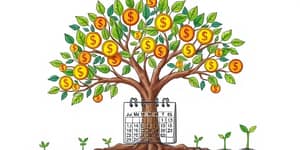
In the modern era, debt touches nearly every household and shapes the broader economic narrative. Understanding the full scope of obligations at both the national and personal levels is the first step toward reclaiming control and paving a path to lasting financial independence.
As of 2023, the United States carries a staggering national debt of 32.91 trillion dollars. Projections estimate this figure will climb to 37.36 trillion by 2025, reflecting persistent imbalances between spending and revenue. Simultaneously, total private nonfinancial-sector debt reached 41.7 trillion in 2024.
Household credit now stands at 20.19 trillion, with mortgages accounting for 13.34 trillion, student loans at 1.78 trillion, auto loans at 1.57 trillion, and credit card balances hitting 1.32 trillion. The average credit card debt per consumer was 7,321 dollars in the first quarter of 2025, up 5.8 percent year over year.
Although only 3.05 percent of those balances are 30 days or more delinquent, this rate has been rising after a prolonged decline, underscoring emerging financial stress among borrowers. Historically, the average delinquency rate has hovered around 3.71 percent, spiking to nearly 7 percent during the Great Recession.
Rising household debt levels can foreshadow broader economic downturns. As delinquency rates climb even modestly, analysts monitor these signals for early indicators of recessionary pressures. Maintaining awareness of shifting macroeconomic trends enables individuals to anticipate tightening credit conditions and adjust their strategies proactively.
Choosing the right approach can mean the difference between prolonged stress and accelerated relief. Financial advisors typically recommend one of four core methods, each with its own advantages and trade-offs.
Beyond these structured plans, direct negotiation with creditors and professional counseling can uncover customized relief options. Engaging a reputable credit counselor may help you secure lower rates or more manageable payment schedules without falling into traps.
Consumers often stumble in two main areas: settlement services and debt collectors. Many companies advertise dramatic reductions in balances but impose fees of 15 to 20 percent of the original debt. Some may not be fully legitimate, resulting in higher costs and longer repayment horizons.
Collection agencies, whether in-house or third-party, must adhere to the Fair Debt Collection Practices Act. Always verify any claimed balance and request written validation before making a payment. State-specific rights vary, so familiarize yourself with the regulations that apply to your locale.
Beware of so-called quick-fix solutions that promise to erase debt overnight. Realistic timelines and transparent cost-benefit analyses help you distinguish between sustainable tactics and misleading offers.
Debt is as much an emotional burden as it is a financial one. Those who adopt the debt snowball strategy often appreciate the subjective momentum that arises from eliminating smaller balances first. Each cleared account can bolster confidence and reinforce positive spending habits.
Conversely, the debt avalanche method shines by reducing total interest paid, but it can test discipline when initial victories are delayed. Research indicates that combining elements of both approaches—such as tackling a small balance first, then switching to high-interest accounts—can harness motivational triggers and mathematical efficiency simultaneously.
Emotional resilience is critical. Celebrating each milestone, no matter how small, can reinforce positive habits and stave off frustration. Sharing goals with a trusted friend or support group further enhances accountability and perseverance.
Taking consistent, structured action is essential. Begin with a comprehensive inventory of all debts, noting balances, minimum payments, and interest rates. Use budgeting software or simple spreadsheets to visualize monthly obligations and identify areas for potential savings.
By adopting these methods, you can convert abstract goals into tangible milestones, steadily moving from indebtedness to autonomy.
Budgeting is more than cutting expenses. It is about aligning spending with values. Allocate funds thoughtfully across essentials, savings, debt repayment, and discretionary categories. Periodic reviews ensure that adjustments reflect changes in lifestyle and income.
Engaging in peer communities—online forums, financial workshops, or local clubs—can provide inspiration and practical tips from those who have successfully navigated similar paths.
If debt becomes overwhelming, don’t hesitate to consult a nonprofit credit counselor. These professionals offer personalized guidance, negotiate with creditors on your behalf, and help design robust repayment plans.
The U.S. regulatory framework offers several safeguards for consumers:
Knowing your rights empowers you to navigate challenging interactions with creditors and collectors with confidence and legal backing.
Continuously track your credit report for accuracy and signs of fraudulent activity. Regularly reviewing all accounts not only verifies that payment histories are up to date, but also helps you maintain a clear view of your evolving financial health.
Debt, whether national or personal, need not be an immutable characteristic of modern life. By understanding the full spectrum of obligations and strategic repayment methods, you can craft a plan tailored to your personality, goals, and financial situation.
In every journey lies the potential for transformation. With deliberate action, disciplined budgeting, and the right mindset, the shackles of debt can be broken. Each payment, each small victory, brings you closer to the sense of freedom and security that defines a truly prosperous life.
Now is the moment to take control: equip yourself with knowledge, leverage proven strategies, and move confidently toward a future unburdened by the weight of debt.
References













